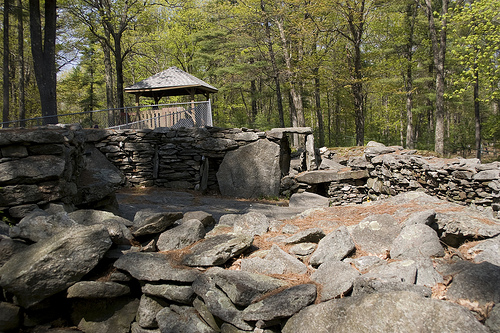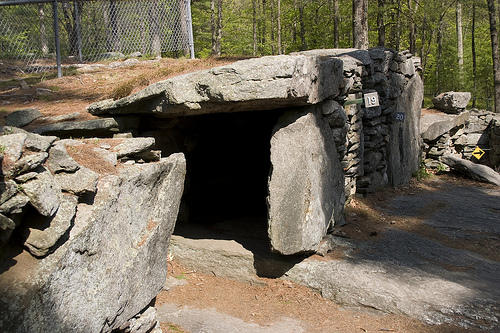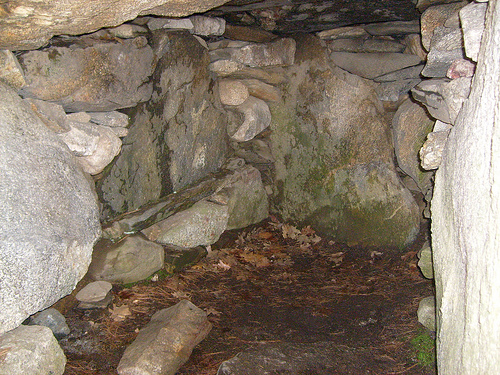


Location: 105 Haverhill Rd Salem, NH Map
Area: 30 acres
Tel. 1 (603) 893-8300
Open: 9am- 5pm daily (last admission 4pm)
America's Stonehenge, also known as Mystery Hill, is a enigmatic archaeological site and tourist attraction spanning approximately 30 acres in Salem, New Hampshire, in the southern part of the state near the Massachusetts border. Situated on a wooded hilltop at 105 acres originally (though the core site is smaller), it features a complex array of man-made stone structures, including chambers, walls, standing stones, and ceremonial spaces, that have sparked intense debate among historians, archaeologists, and enthusiasts. Proponents claim it is the oldest known man-made structure in the United States, dating back over 4,000 years and functioning as a prehistoric astronomical observatory similar to its namesake in England. However, mainstream archaeologists dismiss these assertions, attributing the site's features to 19th-century construction by local shoemaker William Dustin or Jonathan Pattee, with later modifications for tourism. Discovered in the 1930s and opened to the public in 1937, the site draws around 20,000–30,000 visitors annually, offering self-guided tours, educational programs, and paranormal investigations amid its forested trails and rocky terrain. Privately owned and operated by Stonehenge Management LLC since the 1980s, it emphasizes its "mysterious" allure without formal National Register status, blending pseudoscience, Native American history, and New England folklore.
America's Stonehenge occupies a low hill in the Merrimack Valley region of southern New Hampshire, part of the broader New England Upland physiographic province characterized by glacial till, granite bedrock, and rolling terrain left by the retreat of the Laurentide Ice Sheet around 12,000–14,000 years ago. The site sits at elevations of about 200–300 feet (61–91 m) above sea level, on a southwest-facing slope with panoramic views of the surrounding countryside, including nearby farms and the Atlantic coastal plain to the east. The geology is dominated by Devonian-age schist and granite-gneiss, overlain by thin soils of sandy loam and glacial boulders—erratics up to several tons—that were quarried and rearranged to form the structures. Local stone, including mica schist and quartzite, was used for walls and slabs, with some pieces weighing up to 10 tons, suggesting significant labor. The hill's natural drainage creates a network of small streams and wetlands at its base, while the wooded cover of oak, pine, and hemlock provides a shaded, uneven trail system (about 0.5 miles long, with a gradual incline and rocky paths not fully accessible for strollers or wheelchairs). The site's microclimate is temperate, with cold winters (average lows of 15°F/-9°C) that can close trails due to ice, and humid summers (highs around 80°F/27°C) ideal for exploration. No major geological anomalies are present, but the area's karst-like features (small sinkholes) and glacial erratics contribute to the "ancient" aesthetic promoted by site managers.
The human story of America's Stonehenge begins with ambiguous
prehistoric use, potentially by Paleo-Indians or Archaic peoples around
8,000–10,000 years ago, based on scattered artifacts like stone tools
and pottery shards found in the vicinity—though these are not
definitively linked to the structures. More substantial evidence points
to Woodland Period (A.D. 1000–1500) Native American activity, with
archaeologists uncovering arrowheads and ceramics consistent with local
Abenaki or Pennacook tribes, who may have used the hill for seasonal
hunting or ceremonies. European settlement in the 17th century
overlooked the site until the 19th century, when farmer William Dustin
is credited with building some root cellars and walls around 1820–1840
for agricultural purposes, possibly incorporating earlier Native
features. By the 1870s, shoemaker Jonathan Pattee expanded the site into
a homestead with outbuildings, including a shoe shop and living
quarters, using the chambers as storage or workshops—evidenced by
19th-century nails, glass, and pottery found in excavations.
The
site's "discovery" as an ancient wonder occurred in the 1930s during the
Great Depression, when amateur archaeologist Byron Cummings of the
University of Arizona conducted early digs, followed by Harvard's Barry
Fell in the 1970s, who popularized claims of Phoenician, Iberian, and
Ogham inscriptions suggesting transatlantic contact by Celts or ancient
mariners around 2000 B.C. Fell's book America B.C. (1976) thrust it into
pseudohistory circles. In 1937, owner W.T. Robinson opened "Mystery
Hill" as a tourist attraction, adding concrete reinforcements and
interpretive signs. Ownership changed hands multiple times, with the
Christian Science Church acquiring it in 1963 for a youth camp before
selling to William and Jane Good in 1982, who rebranded it "America's
Stonehenge" and invested in carbon dating (yielding dates of 4,000 years
for some charcoal and 7,300 years for a fire pit). By the 1990s, it
became a paranormal hotspot, featured on TV shows like In Search Of...
(1977) and Ancient Aliens. In 2024–2025, recent media coverage,
including a June 2025 WCVB article and August 2025 TikTok/Instagram
reels, highlights ongoing visitor interest amid debates, with no major
new excavations but increased digital promotion via a free app for
self-guided tours.

The site's core consists of over 20 stone chambers, a network of low
walls spanning miles (though mostly on-site), and monolithic
standing stones arranged in a roughly circular pattern reminiscent
of megalithic sites. Key features include:
The Main Chamber
(East Chamber): A 10x10-foot (3x3 m) room with a corbelled roof of
stacked slabs, possibly a root cellar or ceremonial space; it
contains alleged Ogham inscriptions on slabs, interpreted by Fell as
Gaelic but debunked as natural markings or modern carvings.
The
Oracle Chamber: A narrow, phallic-shaped tunnel leading to a small
alcove, claimed as a Druidic oracle but likely a 19th-century well
or privy.
Stone Walls and Cairns: Extensive dry-stone walls (some
3–6 feet high) forming enclosures, possibly field boundaries from
the 1800s, with cairns (piled stones) marking solstice lines.
Standing Stones: About 12 large slabs, including a 13-foot (4 m)
"heel stone" aligned with the summer solstice sunrise, and a
"sacrificial altar" slab with grooves purportedly for blood
channels—though grooves match 19th-century tool marks.
Other
Elements: A "Speaking Stone" slab for acoustics, underground
passages (now reinforced with concrete), and a visitor center with
exhibits on ancient cultures.
The terrain is rugged, with
trails weaving through hemlock groves and open fields, offering a
labyrinthine feel. Artifacts like bronze tools and pottery have been
displayed, but many are of questionable provenance.
Site proponents, drawing from Fell's work, assert America's
Stonehenge functioned as a solar and lunar observatory, with
alignments marking solstices, equinoxes, and moonrises—e.g., the
main slab aligns with the winter solstice sunset, and walls track
the moon's 18.6-year cycle, implying sophisticated astronomical
knowledge akin to Neolithic Europeans. Inscriptions in scripts like
Iberian Punic (dated to 800 B.C. by some) suggest ancient Old World
visitors, supporting theories of pre-Columbian transatlantic voyages
by Celts, Phoenicians, or Templars. Culturally, it's touted as
evidence of a lost Native American megalithic tradition or migrant
European builders, with significance as a "New World Stonehenge"
challenging Eurocentric history.
However, its true significance
lies in cultural anthropology: it reflects 20th-century fascination
with ancient mysteries, influenced by New Age movements and books
like Sacred Stones (1982). For Native communities, it highlights
potential indigenous sacred sites, though tribes like the Abenaki
view claims of European origins as dismissive.
America's Stonehenge is mired in controversy, emblematic of pseudoscience in American archaeology. Mainstream experts, including Boston University's Curtis Runnels, label it a hoax or misinterpretation: carbon dates (e.g., 4,000 B.P. from charcoal) likely stem from campfires, not construction, and the oldest reliable date (7,300 years) is from a single fire pit unrelated to stones. Structures show 19th-century modifications—mortar, concrete reinforcements, and tool marks inconsistent with ancient tech. Inscriptions are widely seen as forgeries or pareidolia (seeing patterns in rocks), with Fell's translations criticized as amateurish by linguists. A 2015 AP investigation and 2024 New Hampshire Magazine article cite Pattee's 1880s homestead as the origin, supported by historical records and nearby 19th-century farms. No peer-reviewed excavations confirm pre-colonial origins; amateur digs in the 1930s–1970s disturbed contexts, and private ownership limits professional access. Critics like the Archaeological Institute of America argue it promotes "fantasy archaeology," potentially obscuring genuine Native sites. Defenders, including site owners, point to soil samples showing no colonial plowing and alignments too precise for 19th-century accidents. A 2024 Reddit discussion notes surface tampering, underscoring the site's role in fringe theories like ancient aliens. Despite this, it educates on archaeology's pitfalls, with calls for independent digs unfulfilled as of 2025.
As a privately operated attraction, America's Stonehenge offers self-guided tours ($16 adults, $12 children 5–12, free under 5; open daily 9 a.m.–5 p.m., weather permitting) along a 0.5-mile trail with interpretive signs, a 12-minute video, and a free app (iOS/Android) for audio narration on alignments and history. Guided VIP tours ($50–$100, by appointment) include access to restricted chambers and research talks. The visitor center features a gift shop selling books, crystals, and replicas, plus an 11-minute film. Seasonal events include solstice celebrations, ghost hunts (due to reported hauntings like shadowy figures), and school programs on astronomy. Trails are moderately strenuous with rocky steps; pets are prohibited except service animals. Nearby, alpacas roam a petting area, adding whimsy. In 2025, digital enhancements like the app and virtual tours (via website) boost accessibility, with recent social media buzz from TikTok videos showcasing "mind-blowing" alignments. Reviews praise the atmospheric woods and mystery but note high admission for a "tourist trap" feel. It's a 45-minute drive from Boston, often bundled with Salem witch trials sites.
Lacking federal protection (not on the National Register due to authenticity doubts), the site is preserved through private efforts by owners who maintain trails, reinforce unstable slabs, and fund basic archaeology like ground-penetrating radar scans (revealing buried walls). Preservation challenges include erosion, vandalism, and tree roots destabilizing stones, with no major funding from grants. Collaborations with Harvard's Peabody Museum (for artifact loans) exist, but professional archaeologists avoid endorsement. As of 2025, the site promotes ethical tourism with "leave no trace" policies, ensuring its enigmatic legacy endures as a quirky New England landmark, whether ancient relic or modern myth.